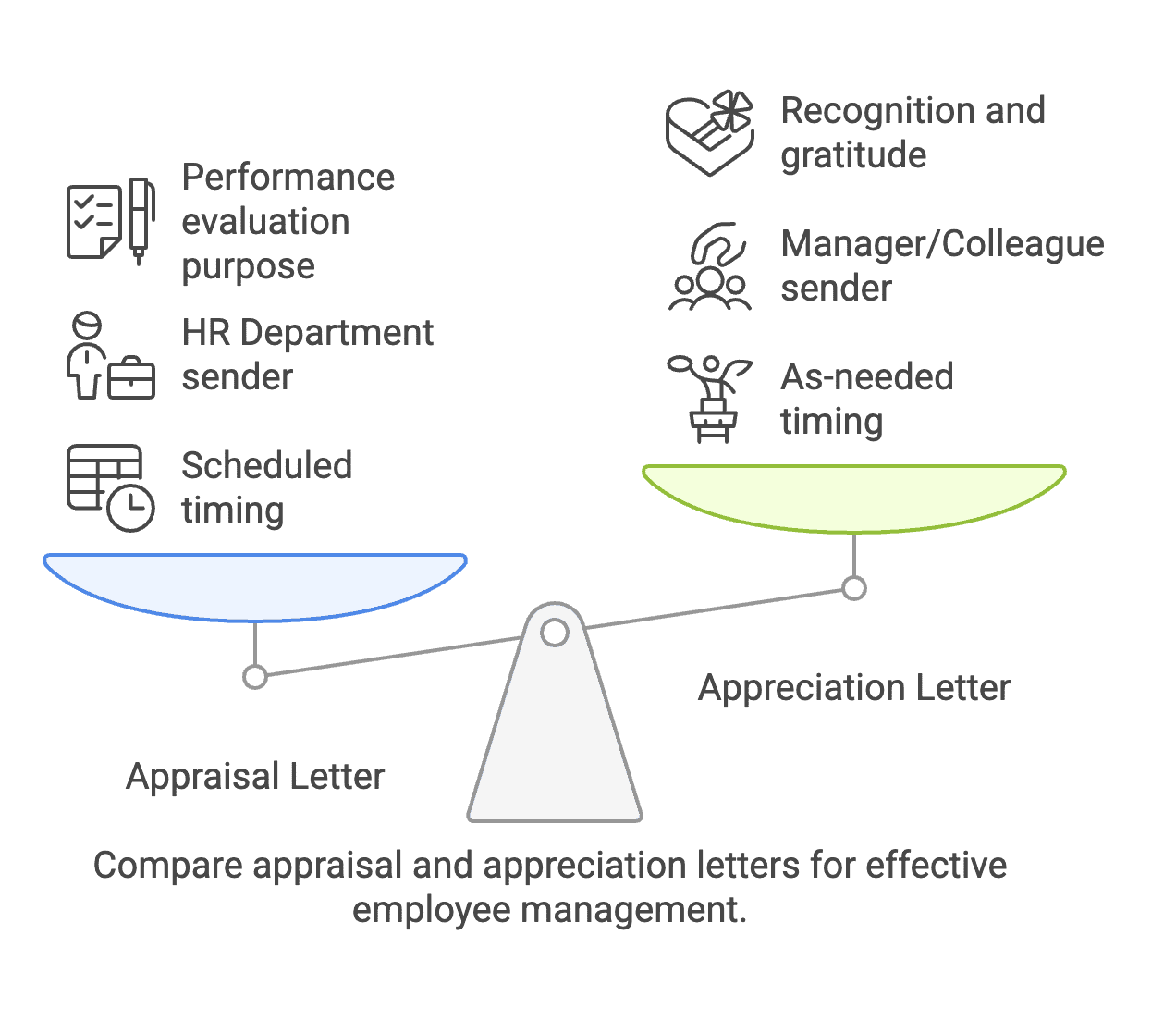People often get confused between an appreciation letter and an appraisal letter. Indeed, both sound the same, but the purpose of both these letters are different. An employee receives an appraisal letter at the end of a performance appraisal that may take place annually or bi-yearly. It depends on the company policy as to how frequently an appraisal process takes place. A manager can send an appreciation letter or a gratitude letter to an employee. Even co-workers send it to other co-workers. It usually congratulates a person for their exemplary performance and can be sent as a token of gratitude.
Both appraisal and appreciation are essential factors of the employee experience. The former takes place once or twice a year, and the latter should be inculcated in the workplace culture on a more frequent basis.
Read on to know how an appraisal letter differs from an appreciation letter and why they are so crucial for the workplace.
Appreciation Letter vs Appraisal Letter: Know the difference

- An appraisal letter is the outcome of a performance appraisal. It is sent to each employee after the performance appraisal, which may take place annually or half-yearly. An appreciation letter can be sent to the employee at any time as and when required.
- The HR department sends the appraisal letter to the employee, whereas an immediate manager is the one who sends an appreciation letter.
- The purpose of the appraisal letter is to provide feedback on an individual’s performance and evaluate their activities during a defined period. An appreciation letter is used to recognize an employee’s outstanding performance.
- All employees receive the appraisal letter after an appraisal process. In contrast, all employees need not necessarily receive an appreciation mail from their boss- it is usually the ones who go above and beyond in their work who receive it.
Why Employee Appreciation Matters
Be it the workplace or at home, professional or personal life, certain fundamental values hold true- the inherent need to feel appreciated for your efforts. When a person feels appreciated and valued, it motivates them to continue to excel. This applies to the workplace in particular. 50% of employees claim that being thanked by managers helps build trust and improves their relationship. On the flip side, Employees who don’t feel appreciated are twice as likely to quit within a year. It is quite evident the crucial role that appreciation plays. But where do you get started? Here’s an employee performance survey created using SurveySparrow..
To create similar employee pulse surveys, employee satisfaction surveys or employee performance appraisals, you can sign up on SurveySparrow for free.
There are many ways to show your employees that you value their work- through employee appreciation programs and public recognition events. But it is the little things that make a huge difference! How about getting started with something small, personal yet highly impactful such as An Appreciation letter.
An appreciation letter sometimes referred to as a thanks letter or a recognition letter is one which an employer gives to the employee to express his gratitude for the exemplary effort they have taken in their work.
What makes a good appreciation letter?
Being appreciated in the workplace can go a long way and serves as a motivator for continuous good work. Most employees wish for appreciation in the form of a simple thank you and that can easily be accomplished with an appreciation letter. So what makes a good appreciation letter?
Make it personalized!
Instead of copying and pasting the same old thank you letter templates that you find on the internet, try to personalize it in your own words. The letter should be heartfelt and should include details of the work you are thanking them for. An honest and open gratitude letter is the best way to make employees feel appreciated for their efforts. Make sure to thank each employee individually, to make a more significant impact.
Recognize their efforts
Recognizing the efforts of your employees seems so simple, but it is rarely done. When writing an appreciation letter, thank them for their contribution and how their contribution played an essential role in achieving the outcome. This will show the employee how you have paid attention to their hard work.
Offer encouragement
Apart from personalization and recognition, another vital constituent of the appreciation letter is encouragement. Encourage your employees to continue the great work or to enhance it further. Such statements prove that the employee is capable and that you believe in their abilities to succeed. Encouragement is the perfect way to end your appreciation letter and gives it a desirable effect.
Why cultivate the practice of employee appreciation letters?
When candidates are considering a job offer, one of the factors that they look out for is whether the management appreciates the employees. A majority of employees know the value of an expression of appreciation for a job well done. One great way to share employee appreciation is through a thanks mail or a thank you note. Try to inculcate this in your organizational culture and make writing a thanks letter a Habit. Take, for example, the story of Pam McCorkle who started a “Thank you note Thursday” event at her local bookstore. She would visit the Local Bookstore in her Wisconsin neighborhood on the third Thursday of each month with a box of cards, stamps and a pen. She reaches out to people within the bookstore and asks if there’s someone who they would like to thank and if there is, they could write out a thank you mail and she would mail it to them.
This practice of thank you notes could be started within the workplace among managers. The benefits are numerous:
- It promotes a culture of thoughtfulness within the company.
- Thanks letters are effortless but create a huge impact.
- Employees would begin to feel appreciated and would work harder. This, in turn, creates a cycle of positive affirmations.
The primary purpose behind appreciation letters is to bring in the practice of appreciation within your workplace. But have you ever wondered if any disgruntled employees feel that they are not being appreciated enough? One way to get a glimpse into your employees’ minds would be through an employee pulse survey. You could use SurveySparrow’s employee pulse survey to gauge whether your employees feel they are appreciated. If the answer is not in the affirmative, spot their discontent early on. Based on their opinions, you could talk with them and take remedial actions immediately.
When should an appreciation letter be given?
An appreciation letter can be given at any time throughout the year, whenever you feel a need to provide one. Here are a few perfect scenarios to write an appreciation letter to an employee:
- On achieving their performance goals
- When they put in extra effort on a project to ensure timely delivery
- For being a good team player and for their contribution to the team
- When they display exemplary leadership and presence of mind during a difficult situation
The list is endless. The takeaway is that it need not just be sent at the end of the year but whenever you feel an urge to.
Types of Appreciation Letters
Various types of appreciation letters can be either formal, semi-formal or casual. It all depends on the company culture. If your company’s culture lies on the informal side, it is more apt to write a casual letter. On the other hand, formal appreciation letters are often written within a formal, corporate company culture.
Anyone can send appreciation letters
When we think of an appreciation letter, the first thing that comes to mind is the one employers give to their employees. But it need not be so. Another perfect situation to send a thank you letter would be right after a job interview. Many forget to do this, but it is one way to create a lasting impression on your interviewer. The thank you letter need not be very formal but should thank the interviewer for his valuable time and reiterate your interest in the position.
Think of someone who did something for you, which you are incredibly grateful about. It can be a colleague at your workplace, a friend, a teacher or a relative. Why not send them a thanks letter?
Depending on the situation it can either be a handwritten thank you note or an email. Research shows that feeling gratitude can significantly improve happiness and overall health in addition to strengthening relationships. The feeling of gratitude sometimes fades away quickly, and one of the best ways to capture it would be through the written form. It would be an exercise in practising the art of gratitude and appreciating the people in your life.
Appraisal letter
An appraisal is an act of evaluating an employee’s performance and achievements during a set period which usually takes place annually or half-yearly. An appraisal letter is given to the employee at the end of a performance appraisal. An appraisal letter is crucial for the employee, and it expresses various details, such as:
- The current designation, current salary and increments, or salary revisions (if any), including the effective date of increment
- Bonuses or rewards as per company policy
- A change in designation, if any
An Effective Performance Appraisal Process
An Effective performance appraisal process is needed to establish an organizational culture of trust and progress and prevents discontent amongst employees. It is conducted systematically to evaluate the employee’s progress and identify their skills and achievements and suggest further improvement. Performance appraisals pave the way for growth and boost staff morale.
Though the primary objective behind all appraisals is the same, different companies utilize different ways to appraise their employees like:
- Self Appraisal– As the name suggests, self-appraisal is a process where the employees review their performance to evaluate their strengths and weaknesses. A self-appraisal gives the employee a voice to share their accomplishments and challenges they faced. It ensures a two-way communication between the employee and manager, whereby the manager can see how each employee perceives themselves. On the downside, Self-appraisals are sometimes prone to the Dunning-Kruger effect, where people tend to overestimate their abilities. It stems from the belief that one is better than the average.
- 360-degree appraisal– The 360-degree appraisal collects feedback from not just their immediate manager, but from all those who work with them. Co-workers, subordinates and managers offer anonymous feedback through 360-degree surveys. There are many 360-degree appraisal tools out there. Why not try using SurveySparrow’s 360-degree feedback tools. Engaging survey templates along with 360-degree reports and in-depth analysis of the feedback data from multiple departments can help you collect an all-round picture of the employee from various perspectives.
- Manager performance appraisal- Usually carried out in conjunction with self-appraisal or 360-degree appraisals. It provides a common ground to discuss your concerns, any roadblocks or challenges that have been faced in your work. In addition to discussing past performances, your manager can map out the areas of improvement and guide you through a plan of action to propel your career forward.
How do you respond to your appraisal letter?
Once you receive the appraisal letter in your email, the next step is to respond to it. Not everyone will hear the news they expect. Whether it is positive, neutral or negative, employees need to learn how to respond respectfully, without letting your emotions get the better of you.
Here are a few scenarios that you may face:
- Positive – This is for employees who received a spectacular report. They have been appreciated for their performance and are all set to get a salary hike. You may go through a range of emotions like pride, excitement and relief. Refrain from bragging about this to your colleagues as they might not have received a similar positive report. The next step is to draft a thanks mail. Don’t forget to reaffirm to work on the improvements that might have been suggested.
- Average – Most of the times, an employee receives an average appraisal. It’s not good, neither is it bad. Have open-ended discussions with your manager on how to raise this average appraisal to an excellent one, the next time around. Gain feedback to assess your strengths and weaknesses.
- Negative and Expected– You had expected to get a negative review, and you realise that your performance was below expectations. But not to worry! Acknowledge whatever went wrong and discuss the action plan with which you expect to make a comeback. Communicate to your manager and team, the kind of support that you will need to implement this action plan. Elucidate how you plan to ensure that your performance does not dip again.
- Negative and Unexpected– An unexpected negative review may leave you shocked, but it is essential to maintain a calm composure. Note the feedback on which you need further clarification and identify the instances where you feel you have performed better than stated in the report. A meeting will help understand why there was a disconnect between your evaluation and that of the manager.
Wrapping it up..
There is no doubt that appreciation and appraisal are two crucial factors in the employee journey. Appreciation is an underlying value that needs to be weaved into the workplace culture, through actions-both small and large. Appreciation letters are a step in the right direction. On the other hand, preparing an appraisal letter is an outcome of the appraisal process. It ensures that the employer can express their feedback on the employee in a concise manner. The best managers are the ones who are continually striving to get better on both appraisal and appreciation, and are open to feedback that helps them do both effectively.






